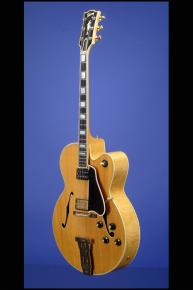"Timeless Elegance - A Jazz Icon - The inspirational Archtop Guitar"
This 17-inch-wide guitar weighs 7.50 lbs. and has a nut width of just under 1 9/16 inches and a scale length of 25 1/2 inches. Perfectly book-matched carved spruce top with a one-piece curly maple back and curly maple sides, three-piece book-matched curly maple neck with two mahogany strips, and multi-bound ebony fretboard with a small, graceful point at the end of the fretboard, 20 jumbo frets, and inlaid pearl block position markers. The neck on this guitar has a medium profile, very similar to that on a '62. Nine-ply binding on the top of the guitar, five-ply binding on the back, and single-bound f-holes. Multi-bound headstock with inlaid pearl "Gibson" logo and pearl "L-5" flowerpot inlay. Black plastic bell-shaped truss-rod cover with white binding and with "Custom" engraved in white. Black-painted headstock rear face with widow's peak. Individual Kluson Sealfast tuners with bell-shaped metal buttons. Two early Gibson patent-number humbucking pickups (with the "L" toolmarks on the feet still clearly visible) with rectangular black labels with "Pat No 2,737,842" on the underside and nicely balanced outputs of 6.93k and 7.38k. Four controls (two volume, two tone) on the lower treble bout, plus three-way pickup selector switch on the treble horn. Black plastic ribbed-side conical-shape "Amp" knobs. Style number ("L5-CESN") and serial number ("537724") on the orange oval printed label inside the bass f-hole (no made in USA on label). Also inside the bass f-hole are "Natural" and "10819" stamped in black. Original multi-bound tortoiseshell pickguard. Gibson Tune-O-Matic retainer bridge with nylon saddles on rosewood base and gold-plated flat plate tailpiece with engraved "L 5" and small hole at the bottom center (for allen wrench tension adjustment). All hardware gold-plated. The cover on the neck pickup had at one time been removed but is now back on. Otherwise this guitar is in near mint (9.25) and totally original condition. Complete with the original "Humbucking Pickup Adjustment" sheet and the "Instructions for the Tune-O-Matic Bridge". Housed in it's original Gibson black 'Lifton' hardshell case with orange plush lining (9.25).
"The ninth model L-5CES was phased in in mid-1969, and its body again featured the Venetian cutaway. This guitar has been continued with some minor changes up to the present day. The shape of this cutaway was changed subtly in the mid-1970s but remained rounded nonetheless. The guitar continued to use Gibson humbucking pickups and the standard tone and volume control setups with pickup selector switch. The pickguards were moved back some from the cutaway and were somewhat shorter than those on the early L-5CES guitars. However, they were the same bound tortoise-like plastic material affixed to the top initially with a forward screw and the Gibson threaded rod and bracket assembly at the rim. However, in the early 1970s the simpler bent bracket was substituted for the threaded rod and bracket assembly, and this bent bracket continues to the present day. The Tune-O-Matic bridge saddle and two-footed bridge base were discontinued in the mid 1970s and were replaced by the Johnny Smith-style ebony bridge base and compensated ebony saddle. The tailpiece remained the same, but it lost the Varitone control in the early 1970s…" Thomas A. Van Hoose. The Gibson Super 400, p. 117-118.
"Timeless elegance. A jazz icon. The inspirational archtop guitar. These are just a few of the descriptions that fit Gibson’s L-5. Add to those a historical antecedent: the L-5 in various forms has been in constant production since late 1922, longer than any Martin, Gretsch, Epiphone, or National model...Originally conceived by acoustic engineer Lloyd Loar, the L-5 was the first guitar with design principles incorporated from carved instruments of the cello family. It represented a complete break from existing guitar design. Sporting simple appointments such as dot fingerboard inlays and a dark sunburst finish, the guitar was elegantly finished with a pearl 'flower pot' inlaid in the headstock below the Gibson logo, and a karat at the end of the fingerboard. The timing of the L-5’s introduction was nearly perfect since the guitar at that time was growing in popularity, but had yet to graduate from being just an instrument of vocal accompaniment to use in ensemble and orchestra settings…Certainly by the early ’40s the L-5 was a staple in jazz band and orchestral settings. At 17" across the lower bout, it was a perfectly sized instrument. Loud enough for orchestral use, but not so large and difficult to handle as Gibson’s Super 400 or the Epiphone Emperor, the L-5 was extremely popular among musicians in jazz, country and western, and large orchestras" (Eric C. Shoaf, "Gibson L-5: Loyd Loar's Timeless Masterpiece" at http://www.vintageguitar.com/brands/details.asp?ID=154).
Translate:









